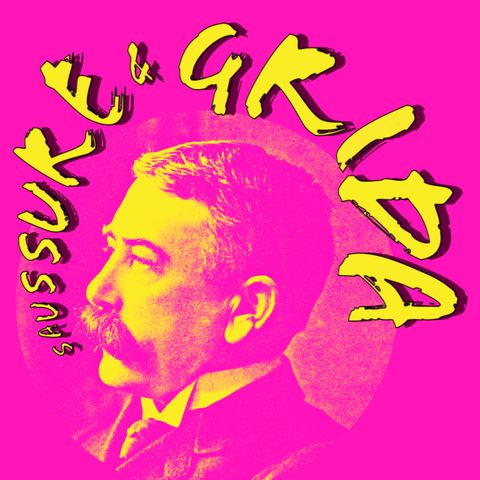20. Che cos'è davvero la balbuzie?

Scarica e ascolta ovunque
Scarica i tuoi episodi preferiti e goditi l'ascolto, ovunque tu sia! Iscriviti o accedi ora per ascoltare offline.
Descrizione
Nella puntata di oggi esploriamo la balbuzie dal punto di vista linguistico, andando oltre la definizione comune di 'disturbo della pronuncia', per capire se riguarda solo la difficoltà di pronunciare...
mostra di piùAnalizzeremo cause, manifestazioni e impatto emotivo, riflettendo su come le ricerche attuali stiano rivelando aspetti nuovi e sorprendenti, anche nelle lingue dei segni, e sulle condizioni in cui la balbuzie può ridursi o scomparire.
Grafiche: Gianluca La Bruna
La sigla è stata prodotta da White Hot e fornita da https://freebeats.io
Fonti:
- Anderson J.D., & Conture E.G. (2000). Language abilities of children who stutter: A preliminary study. Journal of Fluency Disorders, 25:283–304.
- Bloodstein, Oliver. (1949). Conditions under which Stuttering is Reduced or Absent: A Review of Literature. Journal of Speech and Hearing Disorders, 14(4):295-302.
- Carlson N. (2013). Human Communication. In Physiology of behavior (11th ed.:497–500). Boston, MA: Allyn and Bacon.
- Culatta R., & Goldberg S.A. (1995) Stuttering therapy: An integrated approach to theory and practice. Needham Heights, MA: Allyn & Bacon.
- Crystal D. (1987). Towards a ‘Bucket’ Theory of Language Disability: Taking Account of Interaction between Linguistic Levels. Clinical Linguistics & Phonetics, 1:7–22.
- Elrefaie D., Hassan S., Abouella E., & Ibrahim E. (2023). Language Assessment in children with Stuttering. Ain Shams Medical Journal, 74(1): 133-142.
- Irwin M. (2006). Terminology – How should stuttering be defined? And why? In J. Au Yeung & M.M. Leahy (Eds.), Research, Treatment, and Self Help in Fluency Disorders: New Horizons (:41-45). Dublin: The International Fluency Association.
- Kalinowski J., Stuart A., Rastatter M., Snyder G., Dayalu V. (2000). Inducement of fluent speech in persons who stutter via visual choral speech. Neuroscience Letters, 281:198-200.
- Meltzer A. (1992). Horn Stuttering. Journal of Fluency Disorders, 17:257-264.
- Montgomery B.M., & Fitch J.L. (1988). The prevalence of stuttering in the hearing-impaired school age population. Journal of Speech and Hearing Disorders, 53:131-135.
- Perkins W.H., & Kent R.D., Curlee R.F. (1991). A theory of neuropsycholinguistic function in stuttering. Journal of Speech and Hearing Research, 34:734-752.
- Perkins W.H. (1990). What is stuttering? Journal of Speech and Hearing Disorders, 55:370‐382.
- Postma A., Kolk H. (1993). The covert repair hypothesis: prearticulatory repair processes in normal and stuttered disfluencies. Journal of Speech, Language, and Hearing Research, 36(3):472-87.
- Roman K.G. (1959). Handwriting and speech. Logos, 2:29-39.
- Saltuklaroglu T., Robbins M., Kalinowski J., Guntupalli V., & Nanjundeswaran, C. (2005). Speaking While Producing Written Gestures Can Inhibit Stuttering. Paper presented at the American Speech-Language and Hearing Association National Convention, San Diego, CA.
- Silverman F.H., & Silverman E.M. (1971). Stutter-like behavior in the manual communication of the deaf. Perceptual and Motor Skills, 33:45-46.
- Silverman F.H., & Bohlman, P. (1988). Flute Stuttering. Journal of Fluency Disorders, 13:427-428.
- Snyder, G. (2004). Exploratory Research in the Role of Cognitive Initiation in the Enhanced Fluency Phenomenon. Doctoral dissertation. East Carolina University, Greenville NC.
- Snyder, G. (2009). The Existence of Stuttering in Sign Language and other Forms of Expressive Communication: Sufficient Cause for the Emergence of a New Stuttering Paradigm? Journal of Stuttering, Advocacy & Research, 3 : 100 – 107.
Informazioni
| Autore | Irene |
| Organizzazione | Irene Lami |
| Sito | - |
| Tag |
Copyright 2024 - Spreaker Inc. an iHeartMedia Company
